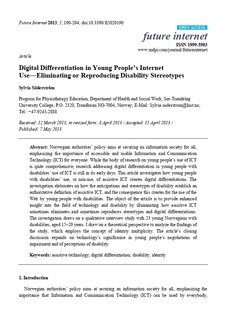| dc.contributor.author | Söderström, Sylvia | |
| dc.date.accessioned | 2019-10-25T12:11:07Z | |
| dc.date.available | 2019-10-25T12:11:07Z | |
| dc.date.created | 2013-05-13T11:04:22Z | |
| dc.date.issued | 2013 | |
| dc.identifier.citation | Future Internet. 2013, 5 190-204. | nb_NO |
| dc.identifier.issn | 1999-5903 | |
| dc.identifier.uri | http://hdl.handle.net/11250/2624468 | |
| dc.description.abstract | Norwegian authorities’ policy aims at securing an information society for all, emphasizing the importance of accessible and usable Information and Communication Technology (ICT) for everyone. While the body of research on young people’s use of ICT is quite comprehensive, research addressing digital differentiation in young people with disabilities’ use of ICT is still in its early days. This article investigates how young people with disabilities’ use, or non-use, of assistive ICT creates digital differentiations. The investigation elaborates on how the anticipations and stereotypes of disability establish an authoritative definition of assistive ICT, and the consequence this creates for the use of the Web by young people with disabilities. The object of the article is to provide enhanced insight into the field of technology and disability by illuminating how assistive ICT sometimes eliminates and sometimes reproduces stereotypes and digital differentiations. The investigation draws on a qualitative interview study with 23 young Norwegians with disabilities, aged 15–20 years. I draw on a theoretical perspective to analyze the findings of the study, which employs the concept of identity multiplicity. The article’s closing discussion expands on technology’s significance in young people’s negotiations of impairment and of perceptions of disability. | nb_NO |
| dc.language.iso | eng | nb_NO |
| dc.publisher | MDPI | nb_NO |
| dc.rights | Navngivelse 4.0 Internasjonal | * |
| dc.rights.uri | http://creativecommons.org/licenses/by/4.0/deed.no | * |
| dc.title | Digital Differentiation in Young People’s Internet Use — Eliminating or Reproducing Disability Stereotypes | nb_NO |
| dc.type | Journal article | nb_NO |
| dc.type | Peer reviewed | nb_NO |
| dc.description.version | publishedVersion | nb_NO |
| dc.source.pagenumber | 190-204 | nb_NO |
| dc.source.volume | 5 | nb_NO |
| dc.source.journal | Future Internet | nb_NO |
| dc.identifier.doi | 10.3390/fi5020190 | |
| dc.identifier.cristin | 1028161 | |
| dc.description.localcode | © 2013 by the authors; licensee MDPI, Basel, Switzerland. This article is an open access article distributed under the terms and conditions of the Creative Commons Attribution license (http://creativecommons.org/licenses/by/3.0/). | nb_NO |
| cristin.unitcode | 194,65,30,0 | |
| cristin.unitname | Institutt for nevromedisin og bevegelsesvitenskap | |
| cristin.ispublished | true | |
| cristin.fulltext | original | |
| cristin.qualitycode | 1 | |

